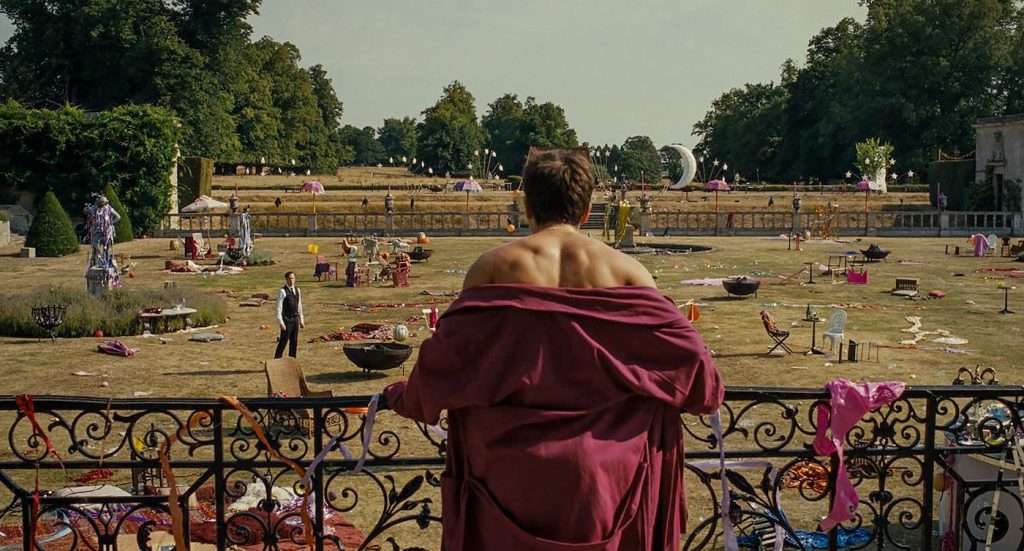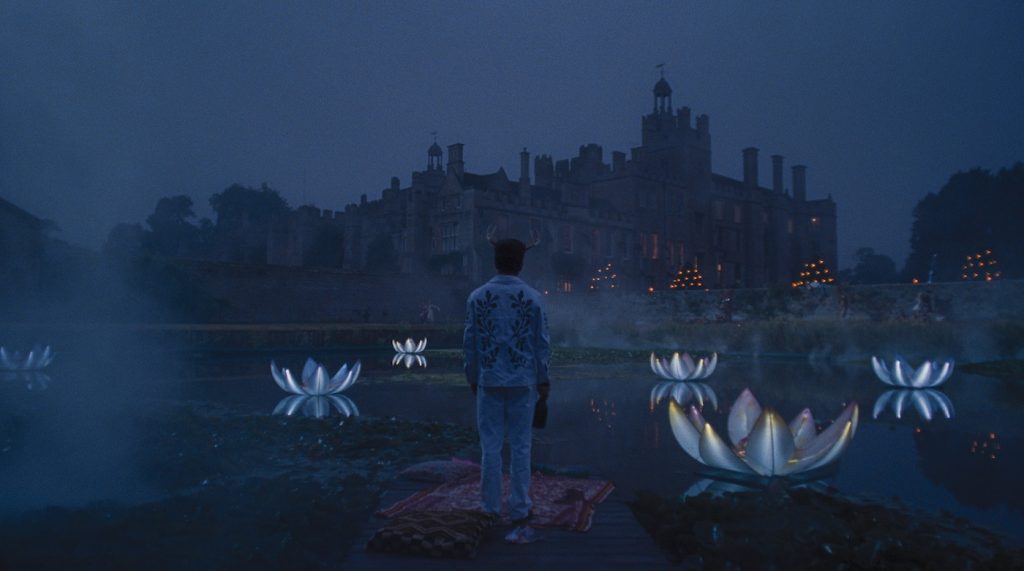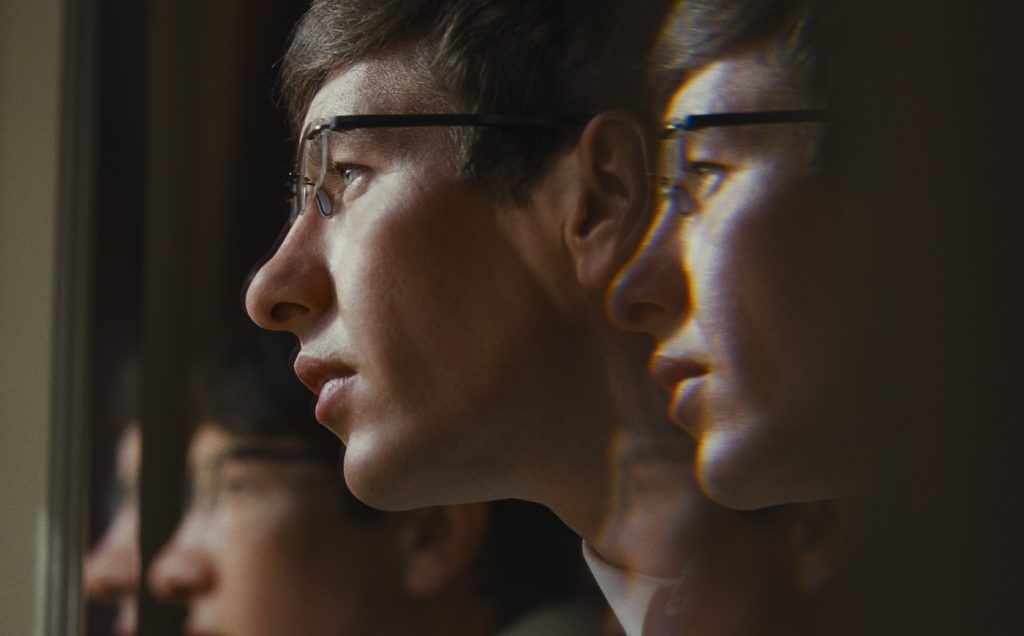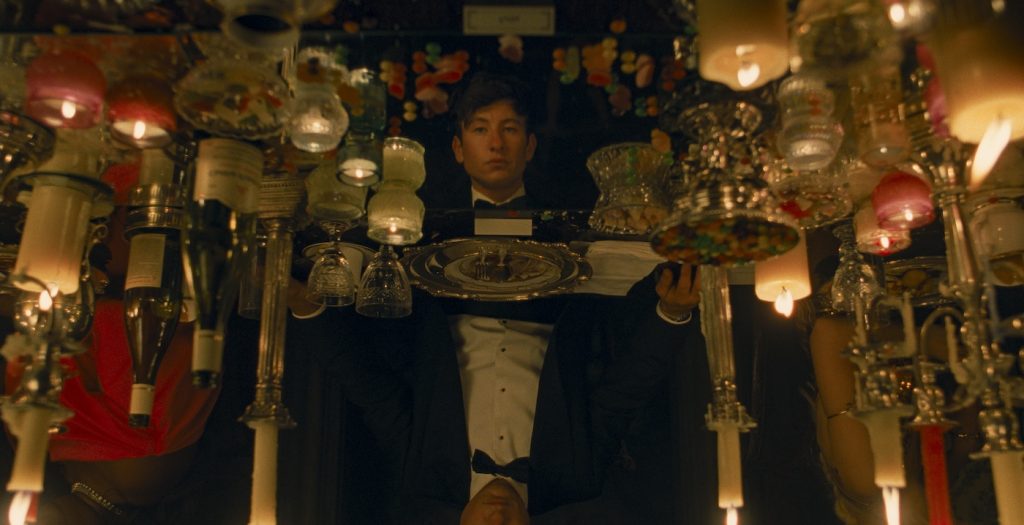“Saltburn” Cinematographer Linus Sandgren on Creating a Fluid Painting for Emerald Fennell
The comic drama Saltburn from director Emerald Fennell (Promising Young Woman) is as beautiful as it is macabre. It’s 2006, and Oliver (Barry Keoghan), an awkward, lonely student at Oxford, finds his place within the scenic confines of his university by becoming friends with Felix (Jacob Elordi), who is everything Oliver is not — handsome, charming, and rich. Felix invites Oliver to spend the summer at Saltburn, his family’s ancestral estate, where Oliver arrives early and sets to work ingratiating himself with Felix’s mother, Elspeth (Rosamund Pike), fending off his rival, Felix’s cousin Farleigh (Archie Madekwe), and creepily seducing Venetia (Alison Oliver), his host’s younger sister.
Saltburn’s interior is a warren of grand, eclectic, art-filled estate rooms. Outdoors, the stunning grounds hold a small lake, more art, and a real hedge maze designed by Adrian Fisher, one of the world’s go-to hedge maze designers. Oliver’s place in this idyllic setting seems like a charitable setup — the nice but poor kid whose haughty, privileged peer takes pity on him — but the story reveals itself to be the opposite. Oliver is a sinister toady, and Felix is actually a pretty good guy.
Fennell’s cinematographer, Oscar winner Linus Sandgren (La La Land, No Time to Die), framed the film’s elegant environs in a tight 1:3:3 aspect ratio and frequently lets the audience observe Oliver’s nerve-rattling behavior from a slight distance. A primary idea behind his approach to Saltburn was to treat the film like an oil painting, one that starts to get distorted as the story heats up. He speaks with us on that motivation and more:
How did you and director Emerald Fennell decide to use a 1:3:3 aspect ratio?
I feel it’s important to make a decision on aspect ratio because it’s a strong tool. Whatever aspect ratio we have will affect the storytelling. In our case, Emerald wanted it to be an expressive film that was real but also heightened. She talked about how she’d like it to feel like peeking into this dollhouse, and she felt that that more square format would benefit that. But the process was long. In prep, I felt attracted to the idea that we could depict the Cattons in a similar way to how their family had been depicted over hundreds of years, in their paintings. That’s more square, too, rather than cinema scope. Then the house had beautiful ceilings and square rooms, and that also felt like it fit. The fourth thing was that Emerald was obsessed with seeing lots of details and close-ups of sweat, armpits, hair, and eyes, and we also felt that the 1:3:3 would benefit that. Then, comparing different aspect ratios, it has a slightly more comical feel to it. Another thing that was important was that Emerald felt like this was sort of a vampire story, and vampire stories at their best [came from] the 1920s or German Expressionism or silent movies, and those were 1:3:3 as well. I think it was right. It’s also fun to compose for paintings. We did a lot of wider shots and left them like that.

It sounds like fine art had a big influence on how you visualized the film.
We always considered how we wanted to tell the story as if it were a painting. In the grave scene, we never shot a closeup of Oliver’s face, because it felt more appropriate to let the viewer be the judge of the emotions in the scene. He’s sobbing, and then he’s getting more and more obscene. It’s sad to watch, but you give the audience the authority to decide for themselves where the line is. If we had dollied in to him, I think that would have felt like we tried to make you feel something. If you don’t, then it’s more like when you look at a painting. Gentileschi has that famous painting of two women beheading a guy. It’s mesmerizing despite the ugliness of what’s going on. That felt very related to what our approach was. Even if you see something that’s hard to watch but depicted in a pleasant way, you give the audience as great an opportunity as possible to like it.
How did you approach lighting the Saltburn estate’s interiors? In daylight, they seem only to be lit through the windows.
We absolutely wanted to work expressively, but I love when you do that in a naturalistic way, so you don’t feel like there are lamps. Sometimes, when you’re in a house and it’s not lit and you have the sun shining in — you see classic examples of that in train stations in Paris in the 1930s and you see these shafts of light coming in — it’s all natural, but it’s also dramatic and expressive. We were attracted by Baroque painters like Caravaggio. They have that dramatic light coming through the windows. So we thought of creating expressive imagery where the house was also this object that hides secrets. It’s full of history. Outside it’s this bright, sunny day, but inside, it’s dark. The soul of the house is very dark. We don’t necessarily want to see everything in the house.
Were you similarly inspired for Saltburn’s grounds and Oxford?
For the exteriors, we had other inspirations— Polaroid photography and fashion photography. We had some English Gainsborough paintings for when it was foggy. Then, we tried to keep the Oxford interiors related to what’s coming. They’re also kind of dark. That had to do more with loneliness and making it feel like Oliver was an outsider, constantly behind these bars. The college was prison-like but also Gothic. We wanted to visually isolate him from the group.

Did the film taking place in 2006 affect your process?
I didn’t consider that at all. Production design and costume design considered that a lot. That was enough, I think. I didn’t think of it as a 2006 flashback priority. A stronger influence for us were the vampire and Gothic themes. The mood was more important than the time. The time was there in the frame.
As we learn the truth about Oliver, is there something in the lighting or camera movement that supports that reveal?
I always try to break it down this way: let’s start with what’s going on emotionally here, what do we need to feel, and how can we visualize that. For that reason, part of the challenge is that you’re opening up this box slowly. On the other hand, in the first scenes, he reveals himself. There’s clearly something that is not right. He sits there in the future and tells this story. We deliberately wanted it to feel nondescript. Throughout the film, we pull out slowly, wider and wider, but we never get to see anything that reveals where you are. He asks the question, ‘Was I love in with him?’ And that becomes the main question for the film. That felt important to connect him and Felix, him and Venetia, him and Farleigh, him and Elspeth, all of it with sexual tension. The only thing we really reveal early on is that he’s a creep because he’s watching Felix making out with this girl in his dorm. That’s the first time you see something that’s not right. We wanted that to be spooky. That was already in the script, how we see this couple, the window, and in the window, this red cigarette glow. The worst thing that could happen to Oliver is to reveal where he comes from, so we wanted to make that look different. We’re taken out of this language we’ve created for the film, and in this case, we wanted the scene to almost feel like a cheap TV drama, to look super normal and simple.

The color red seems to be important to that language.
Red was a theme for production design. There’s the red in the corridor between Oliver’s room and the bathroom, the red when they’re closing the curtains in the dining room, and we had red in the birthday scene. We thought of red as a traditionally symbolic color for lust and love but also for blood and death and internal body color. The heart of the house was red. In that party scene on the staircase, Oliver is illuminated by the birthday cake, and the rest of the people are illuminated by red light. He’s in the heart of the house, but he’s still isolated and completely disconnected from his surroundings. There are hundreds of people on the staircase, but they’re all red, and he’s all yellow. Just symbolically, it’s a clear image of someone who is amongst a bunch of people but is alone.

Saltburn is in select theaters now, and comes to Amazon Prime Video on December 22.
For more on Saltburn, check out these stories:
Featured image: A scene from “Saltburn.” Courtesy MGM.



